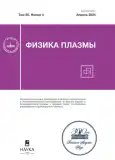Моделирование влияния вакуумной камеры ТРТ на сигналы датчиков системы электромагнитной диагностики
- Авторы: Белов А.М.1,2, Андреев В.Ф.1, Сушков А.В.1
-
Учреждения:
- Национальный исследовательский центр “Курчатовский институт”
- Государственный научный центр РФ “Троицкий институт инновационных и термоядерных исследований”
- Выпуск: Том 50, № 4 (2024)
- Страницы: 427-441
- Раздел: ТОКАМАКИ
- URL: https://gynecology.orscience.ru/0367-2921/article/view/668782
- DOI: https://doi.org/10.31857/S0367292124040056
- EDN: https://elibrary.ru/QDNYCD
- ID: 668782
Цитировать
Полный текст
Аннотация
Приведены результаты модельных численных расчетов, показывающие влияние вакуумной камеры ТРТ на амплитуду и фазу сигналов в магнитных датчиках, которые расположены на внутренней и внешней поверхности вакуумной камеры. Показано, что характерное время в датчиках напряжения обхода существенно зависит от их положения на вакуумной камере ТРТ. Поэтому требуется их тщательное согласование между собой, особенно на динамической стадии разряда, когда в вакуумной камере наводятся большие вихревые токи. Приведены результаты численных расчетов при периодическом возмущении в плазменном шнуре. Они показали, что вакуумная камера практически полностью экранирует сигналы в датчиках формы магнитной поверхности, расположенных на внешней поверхности вакуумной камеры. При этом она влияет не только на амплитуду сигналов в магнитных датчиках, но и на фазу сигналов. Численные исследования позволяет заключить, что приоритетным является расположение датчиков формы магнитной поверхности именно на внутренней поверхности вакуумной камеры ТРТ.
Об авторах
А. М. Белов
Национальный исследовательский центр “Курчатовский институт”; Государственный научный центр РФ “Троицкий институт инновационных и термоядерных исследований”
Автор, ответственный за переписку.
Email: abelov@triniti.ru
Россия, Москва; Троицк, Москва
В. Ф. Андреев
Национальный исследовательский центр “Курчатовский институт”
Email: abelov@triniti.ru
Россия, Москва
А. В. Сушков
Национальный исследовательский центр “Курчатовский институт”
Email: abelov@triniti.ru
Россия, Москва
Список литературы
- Красильников А. В., Коновалов С. В., Бондарчук Э. Н., Мазуль И. В., Родин И. Ю., Минеев А. Б., Кузьмин Е. Г., Кавин А. А., Карпов Д. А., Леонов В. М., Хайрутдинов Р. Р., Кукушкин А. С., Портнов Д. В., Иванов А. А., Бельченко Ю. И., Денисов Г. Г. // Физика плазмы. 2021. Т. 47. С. 970.
- Кадомцев Б. Б. // УФН. 1967. Т. 91. С. 381.
- Strait E. J. // Rev. Sci. Instrum. 2006. V. 77. P. 023502.
- Moret J.-M., Buhlmann F., Fasel D., Hofmann F., Tonetti G. // Rev. Sci. Instrum. 1998. V. 69. P. 2333.
- Edlington T., Martin R., Pinfold T. // Rev. Sci. Instrum. 2001. V. 72. P. 421.
- Lee S. G., Bak J. G., Ka E. M., Kim J. Y., Hahn S. H. // Rev. Sci. Instrum. 2008. V. 79. P. 10F117.
- Coccorese V., Albanese R. // Rev. Sci. Instrum. 2004. V. 75. P. 4311.
- Sushkov A. V., Belov A. M., Igonkina G. B., Kachkin A. G., Khayrutdinov E. N., Melnikov A. V., Sokolov M. M. // Fusion Engineering Design. 2019. V. 146. P. 383.
- Никифоров А. Ф., Уваров В. Б. Специальные функции математической физики. М.: Наука. 1978.
- Тихонов А. Н., Арсенин В. Я. Методы решения некорректных задач. М.: Наука, 1988.
- Kendall E. Atkinson. An Introduction to Numerical Analysis (2nd ed.). New York: John Wiley & Sons, 1989.
- Корн Г., Корн Т. Справочник по математике для научных работников и инженеров. М.: Физматгиз, 1968.
- Медведев С. Ю., Мартынов А. А., Коновалов С. В., Леонов В. М., Лукаш В. Э., Хайрутдинов Р. Р. // Физика плазмы. 2021. Т. 47. С. 998.
Дополнительные файлы








